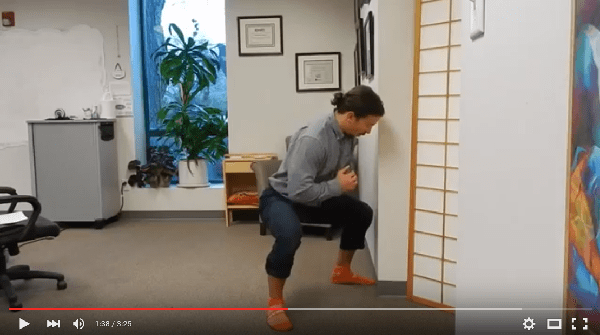
20 Apr Foot Positioning in the Squat and Ankle Dorsiflexion Range of Motion
There is no cookie-cutter squat position.
Why?
Someone wise once said, every snowflake is so unique that there will never be one like it again (or something like that).
In the same way, your mom was right.
You are special.
You need to squat, but it should be on your own terms. Especially if you’ve already overused your leg tissue enough to develop an achilles or plantar fascia problem.
The 3 minute video below will help you determine your ideal foot position while squatting.
How to Find Your Ideal Foot Positioning In The Squat
I already showed you how to measure your ankle dorsiflexion here.
The poorer your dorsiflexion, the wider and more angled out your feet must be.
Determine your ideal foot positioning in the squat by doing the following:
- Face the wall almost perpendicularly (about 5 degrees off the perpendicular). One foot will be against the wall (your anchor foot) and one foot will be inches away from the wall (your moving foot).
- Squat & notice your hip flexion range of motion. You probably didn’t come close to the prescribed 90 degrees.
- Move the moving foot a couple of inches out. Squat again. Notice your depth. You probably got deeper.
- Keep shifting the moving foot out until your hip flexion range of motion is around 90 degrees. Naturally let your feet “toe out” more as they desire. This is your ideal foot position for squatting.
- For giggles, bring your feet wider. What do you notice? You should observe that either your using conscious will to get to the appropriate depth with proper alignment or your knees might cave in (and adduct).
- Resume your natural foot position and squat away.
Rules of Thumb to Squat with Poor Dorsiflexion
DO: Try to increase your ankle dorsiflexion range of motion. Use whatever stretching or mobilizing protocols you’d like. When all else fails, see a qualified myofascial therapist. My recommendation is someone who does ART or ID. Graston or instrument-assisted techniques, while effective in other areas of the body, will have no effect on the calf.
DO NOT: Squat with close feet if you have poor dorsiflexion.
DO: Focus on form to minimize degeneration of all joints so you can squat when you’re 100 years old. Many people being sloppy with form in their 30s are rolling the dice. Don’t be one of them.
 What did you learn? Does using the wall to measure your range of motion make sense?
What did you learn? Does using the wall to measure your range of motion make sense?

Foot Positioning in the Squat and Ankle Dorsiflexion Range of Motion | Primal Docs
Posted at 01:03h, 21 April[…] Foot Positioning in the Squat and Ankle Dorsiflexion Range of Motion […]